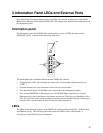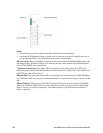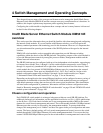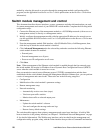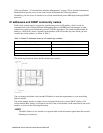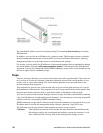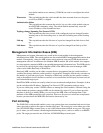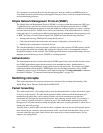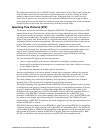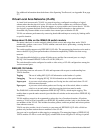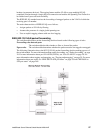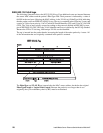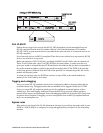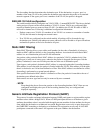Intel® Blade Server Ethernet Switch Module IXM5414E 23
nonvolatile random-access memory (NVRAM) are used to reconfigure the switch
module.
Warm start This trap indicates that the switch module has been restarted; however, the power-
on self-test (POST) is skipped.
Authentication failure
This trap indicates that someone has tried to log on to the switch module using an
invalid SNMP community string. The switch module automatically stores the
source IP address of the unauthorized user.
Topology change (Spanning Tree Protocol (STP))
This trap indicates that one or more of the configured ports has changed from the
learning state to the forwarding state, or from the forwarding state to the blocking
state.
Link up This trap indicates that the link state of a port has changed from link down to link
up.
Link down This trap indicates that the link state of a port has changed from link up to link
down.
Management Information Bases (MIB)
Management and counter information are stored in the switch module in the management
information base (MIB). The switch module uses the standard MIB-II management information base
module. Consequently, values for MIB objects can be retrieved using any SNMP-based network
management software. In addition to the standard MIB-II module, the switch module also supports
its own proprietary enterprise MIB as an extended management information base. This MIB can also
be retrieved by specifying the object identifier (OID) of the MIB as the network manager. MIB
values can be either Read-only or Read/Write.
Read-only MIB variables can be either constants that are programmed into the switch module or
variables that change while the switch module is in operation. Examples of Read-only constants are
the number of ports and type of ports. Examples of Read-only variables are the statistics counters,
such as the number of errors that have occurred, or how much data (in kilobytes) has been received
and forwarded through a port.
Read/Write MIBs variables are usually related to user-customized configurations. Examples of these
are the switch module IP address, Spanning Tree Protocol (STP) parameters and port status.
If you use a third-party vendor’s SNMP software to manage the switch module, a diskette listing the
switch module proprietary enterprise MIBs can be obtained by request. If your software provides
functions to browse or modify MIBs, you can also get the MIB values and change them (if the
attributes of the MIBs permit the write operation). However, this process can become complicated,
because you must know the MIB OIDs and retrieve them one by one.
Port mirroring
The IXM5414E switch module enables you to copy packets that were transmitted and received on a
source port and to redirect the copies to another target port. The source port can be either one of the
four 10/100/1000 Mbps external ports, or one of the fourteen internal blade server ports. The target
port is where you will connect a monitoring/troubleshooting device, such as a sniffer or an RMON
probe. The target port must be one of the four 10/100/1000 Mbps external ports.





